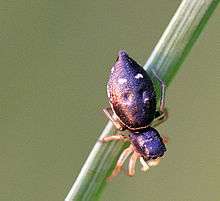Heliophanus cupreus
| Heliophanus cupreus | |
|---|---|
 | |
| Female | |
| Scientific classification | |
| Kingdom: | Animalia |
| Phylum: | Arthropoda |
| Subphylum: | Chelicerata |
| Class: | Arachnida |
| Order: | Araneae |
| Infraorder: | Araneomorphae |
| Family: | Salticidae |
| Genus: | Heliophanus |
| Species: | H. cupreus |
| Binomial name | |
| Heliophanus cupreus Walckenaer, 1802[1] | |
| Synonyms[1] | |
| |
Heliophanus cupreus, the copper sun jumper,[2] is a species of jumping spider belonging to the family Salticidae.[1]
Description
Heliophanus cupreus is a dark, blackish spider, with a metallic sheen. On the female the palps are light brown and contrast with her overall appearance. The male has dark palps with white squamose hairs on front.[3] The tibial apophysis has a fine, long, pointed, hook-shaped process. The male has a long palpal bulb. The cephalothorax is black with a metallic sheen and has white hairs, towards the front bright and on some individuals there are 1-2 bright pairs of spots to the rear. Legs light yellow, with black longitudinal stripes. although some individuals may have uniformly dark legs. The opisthosoma is grey-black, again with a metallic sheen and white hairs.[4]
The respective body lengths of the sexes are males 3.6-4 mm, females 4.6-5.8 mm.[4]
Habitat and ecology
Heliophanus cupreus has been collected from a wide variety of habitat types such as woodlands, grasslands, raised bogs, coastal cliffs and shingle beaches, as well as disturbed habitats such as wastelands and quarries. Within its varied habitats, Heliophanus cupreusis commonly encountered in the drier locations. It is occasionally observed to be active on the surface but is more commonly found within the litter. In northern Great Britain Heliophanus cupreus seems to require sunny conditions. When resting, Heliophanus cupreus may be found in a silken cell placed either under stones or within the litter. The adults of both sexes are found mainly in May, June and July and females may persist into the autumn.[5]
Distribution
Heliophanus cupreus has a Palearctic distribution,[1] being found throughout Europe except Iceland.[4] In Great Britain it has a scattered distribution as far north as central Scotland where it is normally a coastal species.[5]
References
- 1 2 3 4 "Heliophanus cupreus (Walckenaer, 1802)". World Spider Catalogue. Natural History Museum Bern. Retrieved 21 September 2016.
- ↑ "Scottish Invertebrate Habitat Management: Coastal Vegetated Shingle" (PDF). Buglife. Retrieved 21 September 2016.
- ↑ "Heliophanus cupreus (Blackwall, 1834)". University of Copenhagen/Natural History Museum, Aarhus. Retrieved 21 September 2016.
- 1 2 3 "Heliophanus cupreus (Walckenaer, 1802)". Nentwig W, Blick T, Gloor D, Hänggi A, Kropf C: Spiders of Europe. Retrieved 21 September 2016.
- 1 2 "Summary for Heliophanus cupreus (Araneae)". British Arachnological Society. Retrieved 21 September 2016.